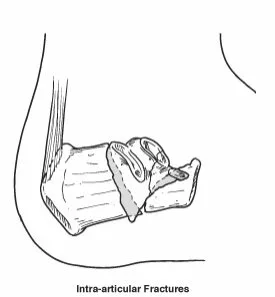What Is the Calcaneus?
Calcaneus fractures, often referred to as heel bone fractures, are injuries that affect the calcaneus, a large bone that serves as the base for the rear part of the foot. The calcaneus connects with the talus and cuboid bones, forming the subtalar joint, which is crucial for normal foot function.
The calcaneus can be likened to a hardboiled egg, featuring a thin, hard shell on the outside and softer, spongy bone on the inside. When the outer shell is damaged, the bone tends to collapse and fragment, making calcaneal fractures severe injuries. In cases where the fracture involves the joints, long-term consequences like arthritis and chronic pain may occur.
Causes of Calcaneal Fractures
Most calcaneal fractures result from traumatic incidents, typically involving a fall from a height, such as a ladder, or an automobile accident where the heel sustains crushing force against the floorboard. Calcaneal fractures can also be triggered by other injuries, such as ankle sprains. Stress fractures, which are caused by overuse or repetitive stress on the heel bone, are less common.
Types of Calcaneal Fractures
Calcaneal fractures can be classified into two main categories: those involving the joints (intra-articular fractures) and those that do not (extra-articular fractures).
Intra-articular fractures are the most severe and can damage the cartilage between bones. The prognosis for recovery depends on the extent of calcaneus damage at the time of injury.
Extra-articular fractures encompass various scenarios, such as avulsion fractures, where a piece of bone is pulled off the calcaneus by the Achilles tendon or a ligament, as well as crush injuries resulting in multiple fracture fragments.
The severity and treatment of extra-articular fractures depend on their location and size.
Signs and Symptoms of Calcaneal Fractures
The signs and symptoms of calcaneal fractures vary depending on whether they are traumatic or stress fractures. Traumatic fractures may cause:
- Sudden heel pain and an inability to bear weight on the affected foot.
- Swelling in the heel area.
- Bruising around the heel and ankle.
Stress fractures, on the other hand, may lead to:
- Gradual onset of generalized pain in the heel area over several days to weeks.
- Swelling in the heel region.
Diagnosis of Calcaneal Fractures
To diagnose and evaluate a calcaneal fracture, a foot and ankle surgeon will inquire about the injury’s circumstances, conduct a physical examination of the affected foot and ankle, and order X-rays. In some cases, advanced imaging tests may also be necessary.
Treatment of Calcaneal Fractures
The treatment approach for calcaneal fractures depends on the type of fracture and its severity. The foot and ankle surgeon will discuss the most appropriate treatment, whether surgical or non-surgical, with the patient.
Non-surgical treatments may include:
RICE (Rest, Ice, Compression, and Elevation) to promote healing, reduce swelling, and alleviate pain.
Immobilization, often involving a cast or cast boot to prevent bone movement, with crutches to avoid weight-bearing.
For traumatic fractures, surgery may be necessary to reconstruct or, in severe cases, fuse the joint. The surgeon will determine the best surgical approach based on the patient’s condition.
Rehabilitation of Calcaneal Fractures
Whether the treatment is surgical or non-surgical, physical therapy is often essential for regaining strength and restoring foot function.
Complications of Calcaneal Fractures
Calcaneal fractures can have serious, long-term consequences, including arthritis, stiffness, and chronic pain. In some cases, the fractured bone may not heal correctly. Other possible complications include reduced ankle mobility and walking with a limp due to heel bone collapse and leg length loss. Patients may require additional surgery or the permanent use of a brace or orthotic device to manage these issues.
Choosing a Foot and Ankle Surgeon
Foot and ankle surgeons, as experts in foot and ankle care, are highly trained specialists. Their education and training are focused on the foot and ankle, making them uniquely qualified to handle various conditions, including calcaneal fractures. They can perform a wide range of surgical procedures if needed for such injuries.







